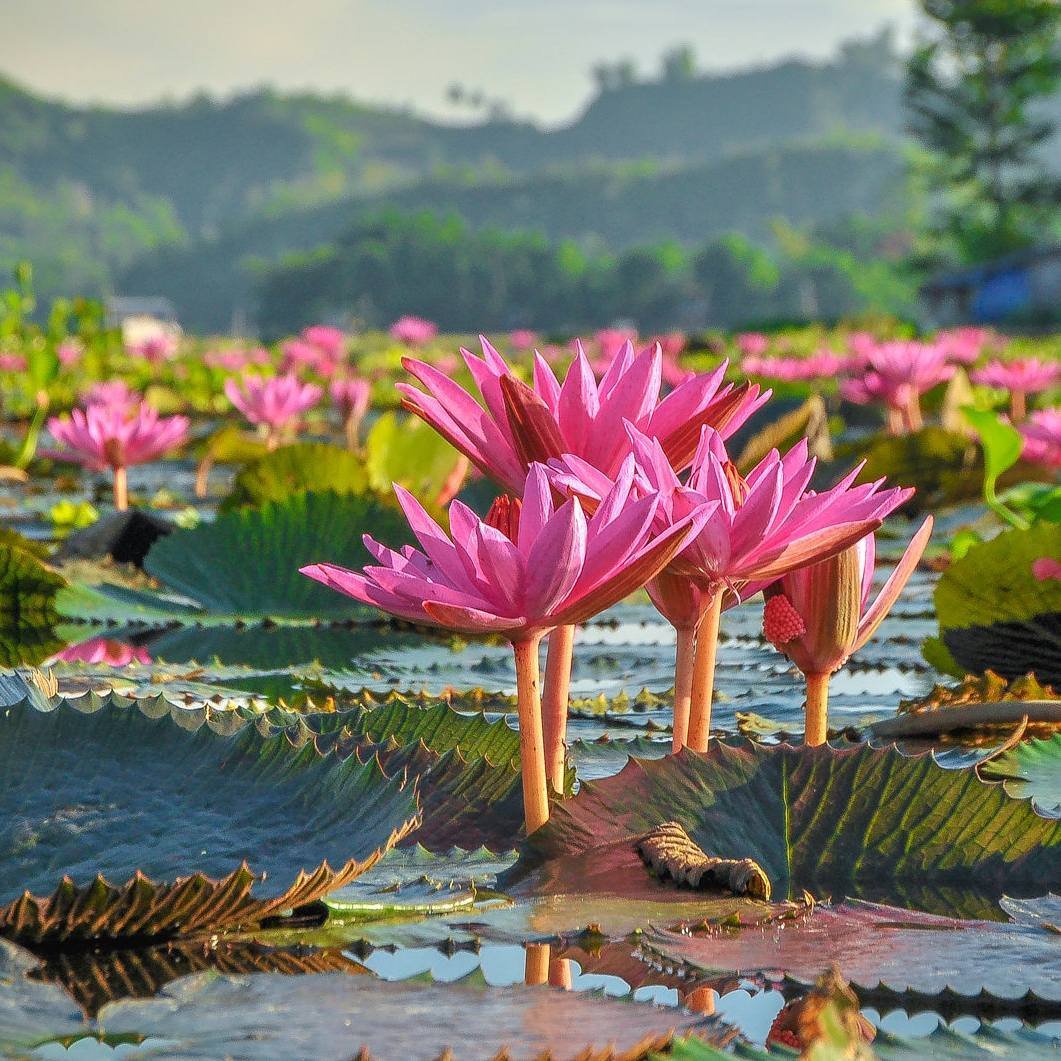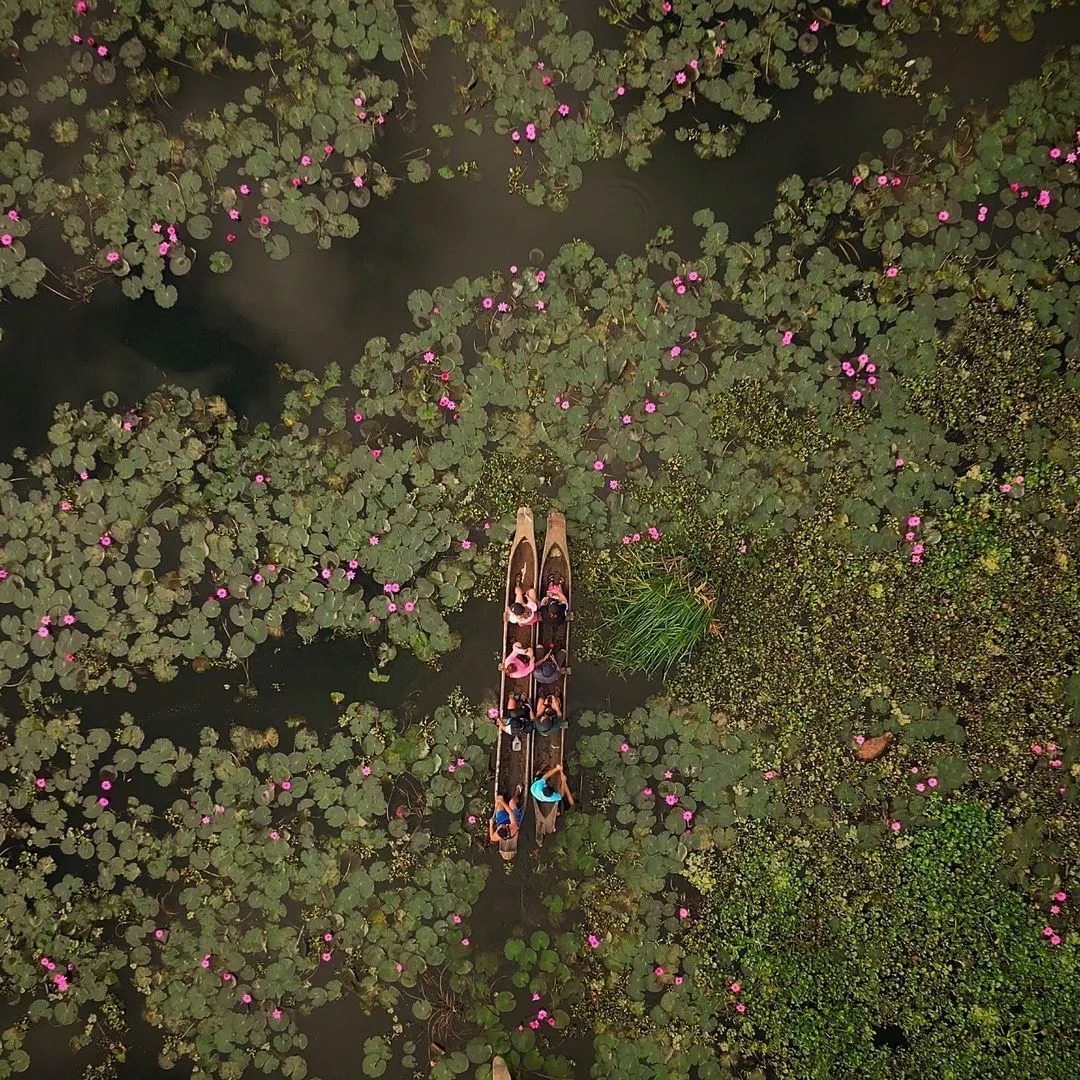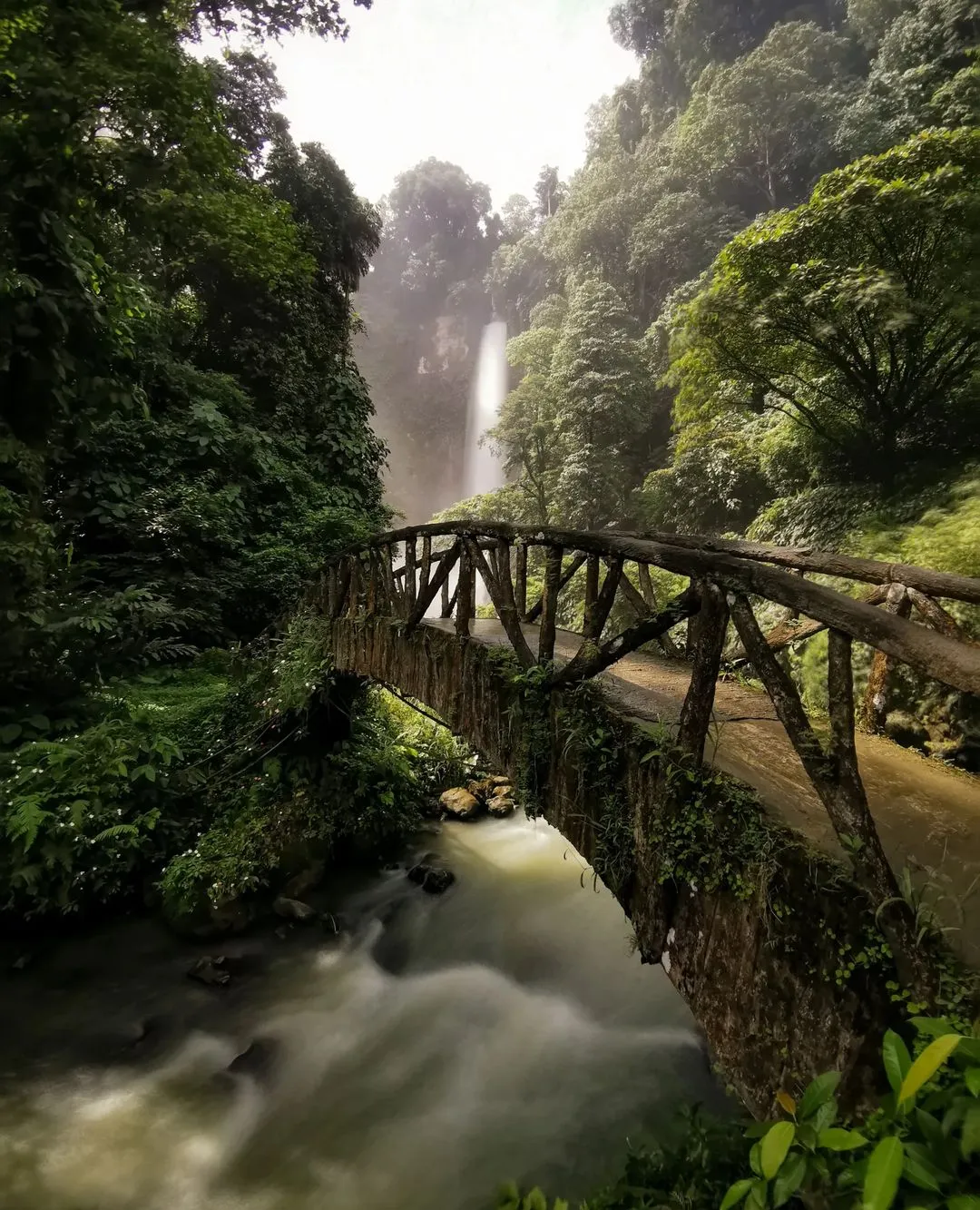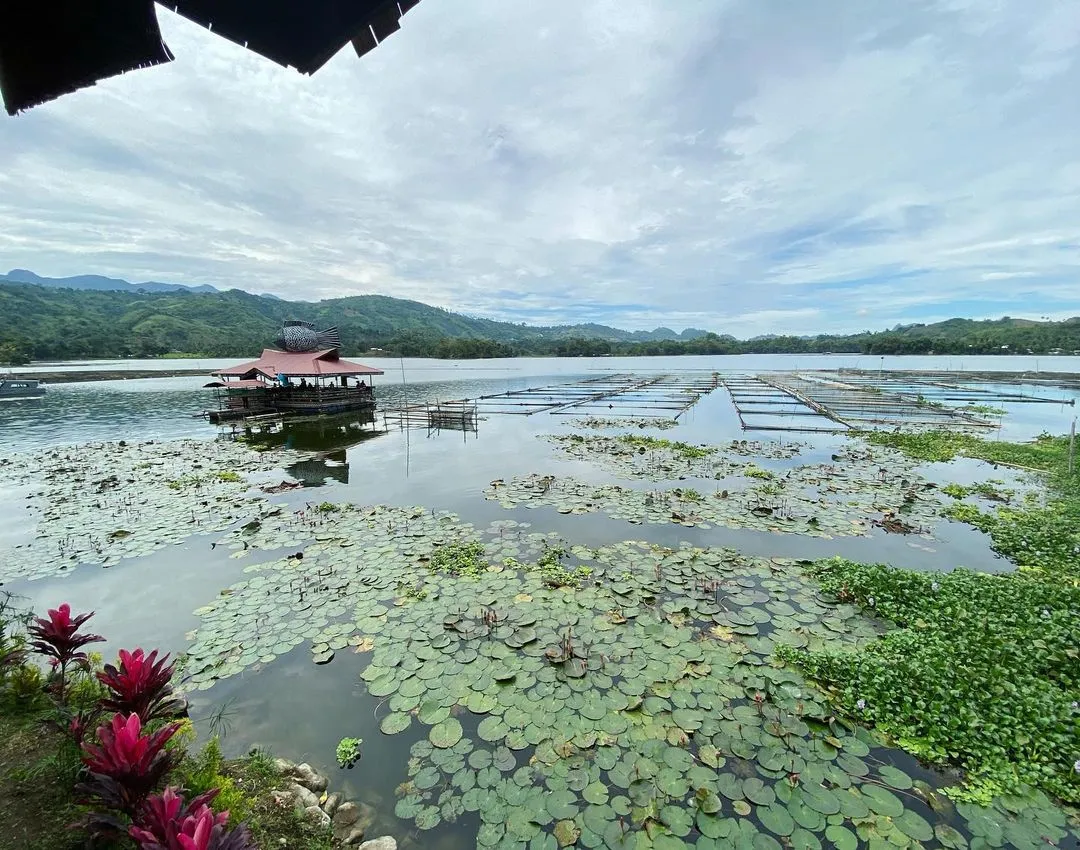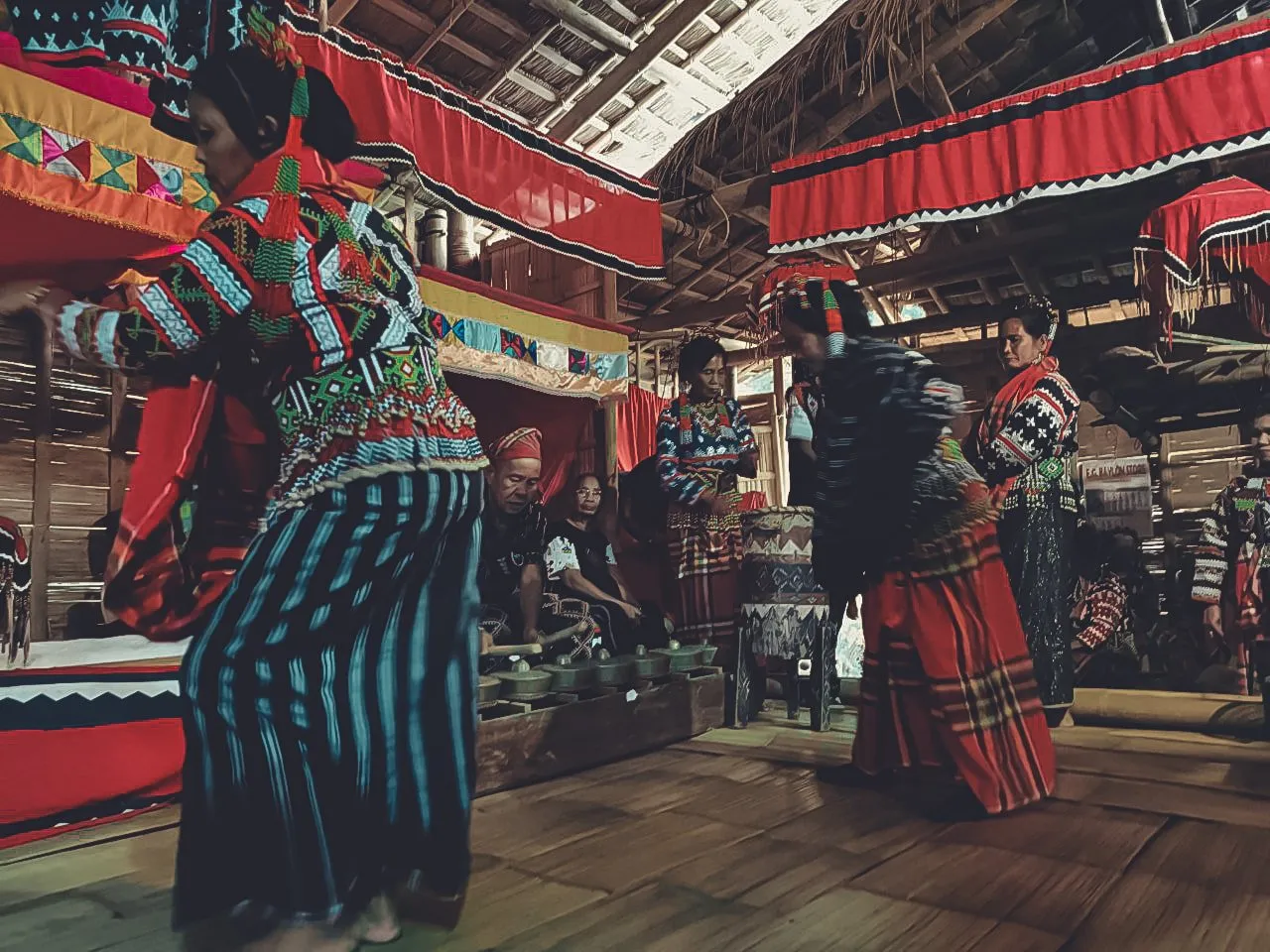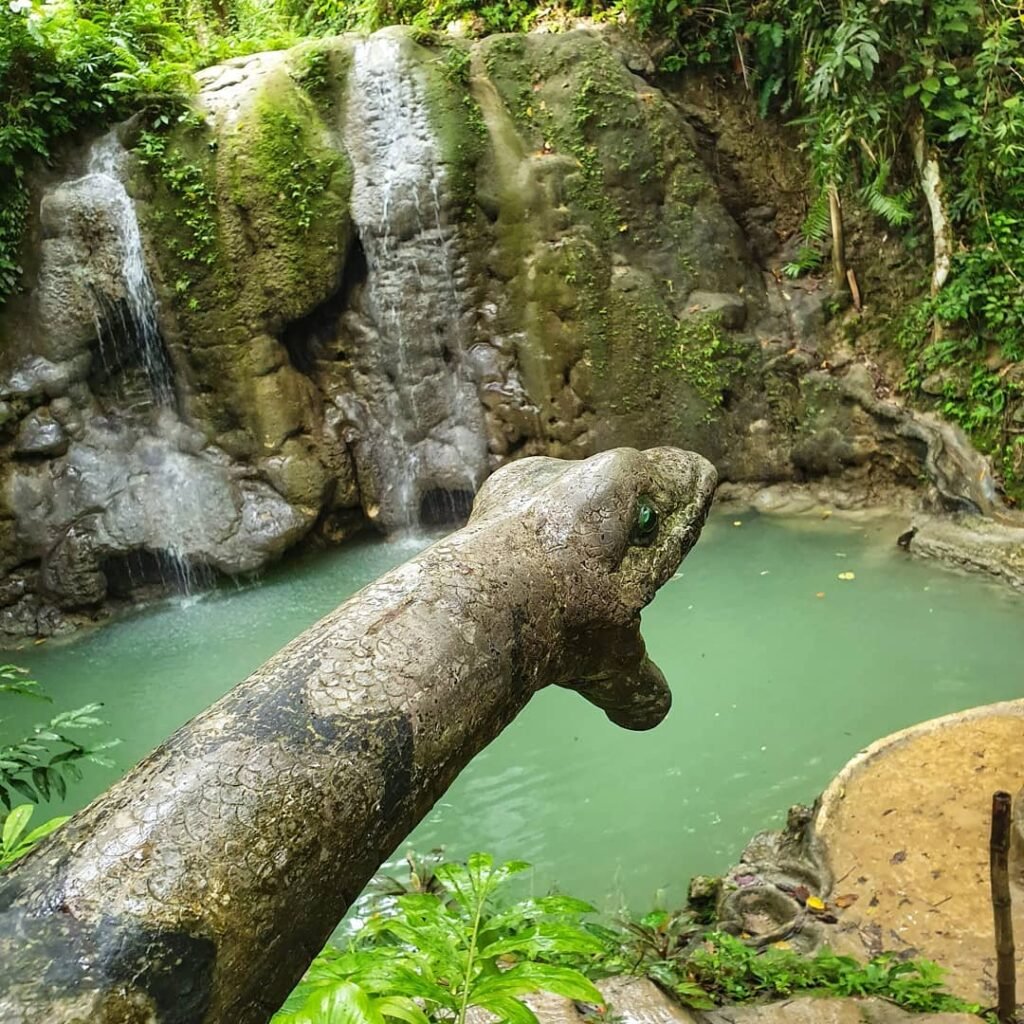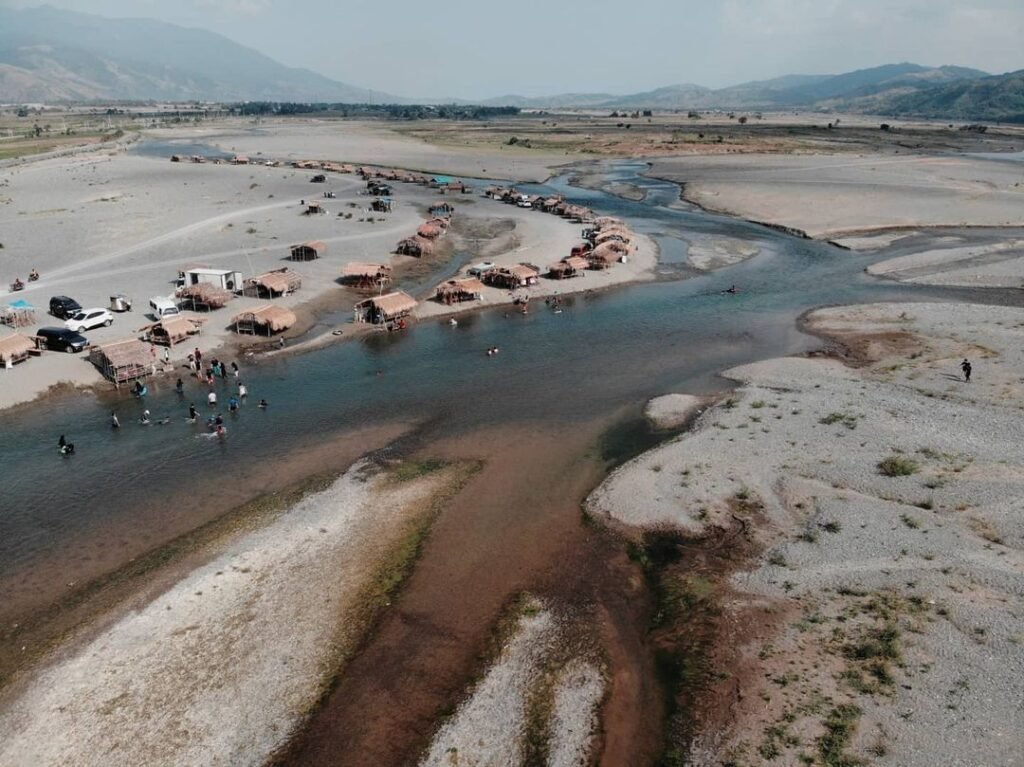Lake Sebu 2026 Quick Guide
-
Best For: Culture chasers, nature lovers, and DIY backpackers.
-
Budget (2D1N): Approx. PHP 5,500 ($100 USD) for a solo traveler.
-
Top Highlight: Flying over the 7 Falls Zipline & meeting the T’boli Dreamweavers.
-
Crucial Tip: The famous pink Lotus flowers operate on a strict clock—they only bloom between 05:30 AM and 08:00 AM. Sleep in, and you miss them.
Introduction: The Highland Frontier of the South
The moment the van climbs out of the sweltering concrete grid of General Santos City and hits the winding roads of the Allah Valley, everything changes. The humidity drops, the air thins, and the chaotic noise of the lowlands is replaced by the rustle of highland cogon grass. Sitting at an elevation of approximately 1,000 meters above sea level, this municipality offers a temperate microclimate that feels more like a rustic Tagaytay than the tropical heat typically associated with Mindanao.
For the traveler in 2026, Lake Sebu represents a rare “frontier” destination. It strikes a difficult balance: it is accessible enough for a weekend expedition, yet remote enough to filter out mass tourism, preserving its soul as the Ancestral Domain of the T’boli and Ubo tribes. This is not a manicured resort town; it is a living cultural landscape where the “Dreamweavers” still create intricate T’nalak fabrics from abaca fibers and visions received in their sleep.
However, navigating Lake Sebu requires a shift in mindset. While the region is safe and welcoming, modern conveniences like 5G and ATMs are developing rather than guaranteed. This guide moves beyond the surface-level advice to provide the ground-level logistics you need—from catching the elusive early morning lotus blooms to understanding the specific transport relays required to get here efficiently.
While Lake Sebu is a highlight of South Cotabato, it is just one gem in a massive region. For a broader look at safe and stunning destinations here, check out our complete
Table of Contents
Essential Travel Requirements & Updates (2026)
Lake Sebu is open to all domestic and international travelers. As of 2026, no special permits or pre-registration are required for entry, though securing accommodation in advance is highly recommended due to limited room inventory at popular lakeside resorts.
Safety: The Reality vs. The Stigma
For many first-timers, the biggest barrier to visiting South Cotabato is the historical “Mindanao Stigma.” It is crucial to distinguish this municipality from the volatile regions of Western Mindanao. Lake Sebu sits within the peaceful SOCCSKSARGEN region, a well-established eco-tourism zone.
Travelers will encounter several military and police checkpoints along the highway from General Santos City. Do not be alarmed; these are standard security protocols in Mindanao and should be viewed as safety assurances rather than warning signs. The area is stable and frequented by solo backpackers, families, and school groups.
Connectivity: The Digital Nomad Reality
If staying connected is a priority, bring a Smart Communications SIM card. Smart generally offers superior coverage compared to Globe Telecom in this highland terrain. While you can expect reliable 4G/LTE speeds in the town proper and at major resorts like Punta Isla, the signal often degrades to 3G or H+ (sporadic data) as you move toward the Seven Falls or the remote weaving centers. Download your maps and music offline before leaving the lowlands.
Best Time to Visit Lake Sebu
The optimal window for visiting is during the dry season from February to April for the clearest skies, but the most critical timing isn’t the month—it is the hour. While Lake Sebu is accessible year-round, the defining experience of the trip relies entirely on waking up before the sun.
The Lotus Bloom Window: A Strict Circadian Rhythm
The region’s famous pink lotuses operate on an uncompromising biological clock. These flowers begin unfurling at first light around 05:30 AM, reach their peak vibrancy between 07:00 AM and 08:00 AM, and close tightly as the sun intensifies by mid-morning.
The Reality Check: Many tourists make the fatal logistical error of scheduling their dugout canoe (owong) tour after breakfast. If you arrive at the lakeside terminal after 09:00 AM, you will not see a sea of pink blooms; you will see a field of closed green buds. This requires a non-negotiable 5:00 AM wake-up call.
The Highland Microclimate: “Baguio of the South”
Sitting at an elevation of approximately 1,000 meters, the municipality maintains a temperate climate that contrasts sharply with the humid heat of General Santos City. The weather is often compared to Tagaytay or Baguio, characterized by crisp mornings and cool evenings.
Insider Tip: Do not underestimate the wind chill. Since the primary mode of local transport is the habal-habal (motorcycle taxi), the rush of cold air on a moving bike can be biting. Packing a light windbreaker or a versatile malong is mandatory for comfort, especially for the early morning ride to the Seven Falls. Additionally, because this is a watershed area, scattered rain showers are common even during the dry months—always have a dry bag ready for your electronics.
How to Get to Lake Sebu (The “Relay Route” Strategy)
From Manila, fly to General Santos (GES), then proceed to Bulaong Terminal where the most reliable transport option is the “Relay Method”: take a Yellow Bus to Koronadal (Marbel), transfer to a van for Surallah, and finally catch a jeep or van to the town proper. While direct vans from GenSan exist, they are infrequent and operate on a strictly “fill-and-go” basis, making them risky for time-sensitive travelers.
Phase 1: The Aerial Bridge (Manila to GenSan)
Your logistics begin before you even land. To execute a seamless 2D1N itinerary, you must book the earliest flight out of Manila (MNL), typically departing between 4:00 AM and 6:00 AM.
-
The Reality Check: Arriving in General Santos after 12:00 PM is a logistical point of failure. It compresses your travel window and increases the risk of missing the last connecting trip in Surallah.
Phase 2: Airport to Hub (GES to Bulaong Terminal)
General Santos International Airport is located about 14 kilometers from the city center.
-
Taxi (Recommended): The most efficient choice. White taxis queue at the arrival area. Expect to pay a fixed or metered rate of approximately PHP 400 – PHP 500.
-
Multicab (Budget): Available outside the airport gate for PHP 50. However, these wait to fill up and make frequent stops. Only choose this if you have zero luggage and infinite patience.
Phase 3: The Overland Odyssey (Choose Your Fighter)
Option A: The “Express” Trap (Direct Van)
At the Van Section of Bulaong Terminal, you may find vans marked for Lake Sebu.
-
The Pros: No transfers.
-
The Cons: They only leave when every single seat is sold. You could wait 15 minutes or 2 hours.
-
Crucial Warning: The last direct van often departs as early as 2:00 PM. If you arrive later than this, do not wait—switch immediately to the Relay Route.
Option B: The “Reliable” Relay (Recommended)
This three-leg protocol is virtually fail-safe during daylight hours.
Leg 1: GenSan to Koronadal (Marbel)
Board a Yellow Bus Line (YBL) or Husky Tours bus. These are air-conditioned, comfortable, and depart every 30 minutes.
-
Insider Tip: Verify with the conductor if the bus terminates in Marbel or continues to Surallah. Some YBL buses go all the way, saving you one transfer.
Leg 2: Marbel to Surallah
If your bus stops at the Koronadal Integrated Terminal, transfer to a van or commuter bus heading to Surallah. The ride is a quick 30-45 minutes.
Leg 3: Surallah to Lake Sebu
This is the final stretch. At the Surallah terminal, board a passenger van or jeepney.
-
The Deadline: Public transport here generally ceases operations by 6:00 PM. If you arrive in Surallah after dark, your only option is to charter a private habal-habal (motorcycle) for a premium price (PHP 200+).
Transport Cost Matrix (2026 Estimates)
| Segment | Mode | Est. Cost (PHP) | Operational Notes |
| Airport Transfer | Taxi | 400 – 500 | Fixed rates common; negotiate first. |
| GenSan to Marbel | Yellow Bus Line | 110 – 135 | Air-conditioned; departs every ~30 mins. |
| Marbel to Surallah | Van / Bus | 35 – 60 | Short transit; efficient transfer. |
| Surallah to Lake Sebu | Jeep / Van | 35 – 50 | Last trip approx. 6:00 PM. |
| Direct Option | Van (GenSan-Sebu) | 150 – 200 | Fast but unpredictable schedule. |
Practical Takeaway: Ignore the direct vans unless one is already full and revving its engine; the YBL relay is consistently faster because it keeps you moving.
Where to Stay in Lake Sebu: Resort vs. Homestay
Accommodation in Lake Sebu falls into two distinct categories: commercial resorts like Punta Isla for classic lake views and standard comforts, or cultural homestays like the School of Living Traditions (SLT) for an immersive deep dive into T’boli heritage. Your choice depends entirely on whether you prioritize privacy or cultural connection.
The Cultural Choice: School of Living Traditions (SLT)
For the traveler seeking to understand the soul of the “Dreamweavers,” this is the superior option. Operated by cultural custodian Maria “Oyog” Todi, the SLT is not a hotel; it is a learning center.
The Vibe: Guests sleep in a traditional Gono Bong (long house). There are no private rooms. You sleep communally on mats with mosquito nets, listening to the sounds of nature and traditional music.
The Privilege: The trade-off for the lack of privacy is access. You may wake up to the sound of chanting or watch the intricate process of brass casting and weaving right in the living area. It is a rare opportunity to live with the community, not just observe it.
Contact: +63 935 456 9359 (Booking is essential as space is limited).
The Resort Tier: Punta Isla & Sunrise Garden
If you prefer a private bathroom and a solid mattress, the lakeside resorts are your safety net.
Punta Isla Lake Resort: The undisputed hub of tourism in the municipality. It offers the most iconic views of the water and features a floating restaurant.
Reality Check: Because it is the most popular, it can get crowded with day-trippers. Service at the restaurant often slows down during the lunch rush (11:00 AM – 1:00 PM), so order early.
Sunrise Garden Lake Resort: Located near the quieter Lake Seloton, this is a budget-friendly alternative. It feels more secluded and offers a “countryside” atmosphere, often at a lower price point than the main resorts.
The Reality Check: Managing Expectations Regardless of where you book, manage your expectations regarding “luxury.” In this highland destination, hot showers are a premium amenity not found in standard rooms, and WiFi is often intermittent or non-existent inside the cottages. Treat this digital detox as a feature, not a bug.
Practical Takeaway: For a 2-day trip, spend your day at the resorts for the food and views, but sleep at the SLT for the stories you won’t find on Instagram.
Top Things to Do in Lake Sebu
The essential Lake Sebu itinerary rests on three pillars: high-altitude adrenaline at the Seven Falls, quiet introspection at the Lotus Garden, and deep cultural immersion with the T’boli Dreamweavers. While there are side trips like the T’daan Kini Falls or spelunking, these three experiences form the non-negotiable core of any first-time visit.
1. The 7 Falls Zipline (Hikong Alo to Hikong Bente)
The most efficient and spectacular way to view the waterfalls is not by hiking, but by strapping into one of the highest ziplines in Southeast Asia.
While the ecopark protects a series of seven cascading falls, only the first two are easily accessible to the average tourist.
-
Falls 1 (Hikong Alo): This broad, powerful curtain of water is just a short walk from the entrance gate. It is the most photographed spot because of its accessibility.
-
Falls 2 (Hikong Bente): This is the tallest and most visually striking of the group. However, the steep hiking trail connecting Falls 1 to Falls 2 consists of hundreds of steps and is frequently closed for safety maintenance.
The Zipline Solution: This is where the adventure becomes functional. The zipline consists of two legs—740 meters and 420 meters—that suspend you hundreds of feet in the air. As you fly across the first leg, you pass directly over the roaring mouth of Hikong Bente. It offers a perspective that is physically impossible to achieve from the ground, turning a simple sightseeing trip into an aerial expedition.
![Insert Photo of Zipline over the waterfall with Alt Text: Tourist riding the 740-meter zipline over Hikong Bente waterfall in South Cotabato]
-
Cost: Approximately PHP 300 – 350 (Weekday/Weekend rates apply).
-
Insider Tip: If you are traveling as a pair, you can request a “tandem” ride. It’s not just romantic; the added weight often makes for a faster, smoother glide against the wind.
2. The Morning Lotus Canoe Ride
For a sensory reset, rent a traditional owong (wooden dugout canoe) and drift through the Lotus Garden before the rest of the town wakes up.
Unlike the motorized tours that dominate other lakes, the owong experience is defined by silence. You hear only the dip of the paddle and the rustle of the birds in the lakeside reeds. The T’boli boatmen are master navigators of these waters, steering you through dense clusters of pink lotus flowers that rise tall above the surface.
-
The Critical Window: As emphasized in the timing section, you must be on the water between 05:30 AM and 08:00 AM. By 9:00 AM, the heat forces the flowers to close, transforming the vibrant pink carpet into a sea of green buds.
-
Cost: PHP 300 per boat (good for 2-3 pax).
-
Reality Check: The boat is small and sits low in the water. You will get splashed. Wear quick-drying shorts or hiking sandals, and secure your phone in a waterproof pouch.
3. Cultural Immersion: Gono Jem & Lang Dulay Center
To visit this region without acknowledging the T’boli heritage is to miss the point of the destination entirely.
The T’boli are known as the “Dreamweavers” because their intricate T’nalak fabric patterns are said to be visited upon them in their sleep by the spirit Fu Dalu. This is not just a textile; it is a sacred record of their history.
-
Lang Dulay Weaving Center: Located in Sitio Tukolefa, this workshop preserves the legacy of the late Lang Dulay, a National Living Treasure (Manlilikha ng Bayan). Here, you can watch the younger generation stripping abaca fibers, dyeing them with natural pigments, and weaving them on backstrap looms.
-
Gono Jem (T’boli Museum): A private museum housing centuries-old brass casting tools, musical instruments like the hegalong, and family heirlooms. It provides the historical context necessary to appreciate the weaving.
Visitor Etiquette (Crucial):
-
Remove Footwear: Always take off your shoes before entering a weaving center or traditional house.
-
Ask First: While they are accustomed to tourists, always ask permission before taking close-up photos of the weavers, especially elders.
-
Silence: Weaving requires intense mathematical concentration. Keep your voice low.
Practical Takeaway: Authentic T’nalak is expensive, often costing thousands of pesos per roll, reflecting the months of labor required. If you cannot afford a roll, small accessories like wallets or bracelets are excellent ways to support the local economy directly.
What to Eat in Lake Sebu (The Tilapia Capital)
The culinary identity of this highland town is built entirely around fresh Tilapia, harvested daily from the floating aquaculture cages and served in over 50 different variations ranging from crispy appetizers to rich stews. If you leave without trying at least three versions of this fish, you haven’t really visited.
![Insert Photo of Chicharon Tilapia and Sinanglay with Alt Text: A platter of crispy Chicharon Tilapia and a clay pot of Sinanglay na Tilapia in coconut milk]
The Essential Menu
While resorts boast extensive menus, two dishes define the local palate:
Chicharon Tilapia: This is the non-negotiable appetizer. Unlike the pork variety, this consists of tilapia fillets (and sometimes skin) deep-fried in a light batter until they achieve a shattering crunch. It is widely regarded as a guilt-free, equally addictive alternative to the classic Filipino snack, best paired with spiced vinegar.
Sinanglay na Tilapia: For the main course, this is the “must-try.” Fresh fish is stuffed with ginger, onions, and tomatoes, wrapped carefully in pechay (bok choy) or mustard leaves, and slowly stewed in rich coconut milk (gata). The result is a creamy, savory dish that highlights the natural sweetness of the freshwater catch.
Dining Venues: Views vs. Value
The Experience (Punta Isla Floating Restaurant): This is the most famous dining spot, where you eat on double-decked floating barges.
Reality Check: You pay for the ambiance. Service can be sluggish during the 12:00 PM rush due to the volume of day-trippers. Bring patience.
The Budget Option (Local Carinderias): For a faster, cheaper meal, the small eateries near the transport terminal serve Nilasing na Tilapia (marinated in liquor) and grilled dishes for half the price of the resorts.
Practical Takeaway: Order the “Tilapia Sisig” as a side dish—it offers the savory kick of the original Pampanga classic but with a lighter, flakier texture unique to Lake Sebu.
The Perfect 2D1N Lake Sebu Itinerary
This operational blueprint prioritizes logistical efficiency, placing the time-sensitive Lotus Garden tour in the prime biological slot on Day 2 while front-loading cultural immersion. By adhering to this schedule, you avoid the common mistake of missing the morning blooms or getting stranded by the early transport cutoff.
Day 1: The Ascent & Cultural Immersion
-
06:00 AM: Depart General Santos (Bulaong Terminal). Execute the Relay Strategy (Bus to Marbel → Van to Surallah → Jeep to Lake Sebu) to ensure continuous movement.
-
09:30 AM: Arrival & Logistics. Immediately negotiate a “2-Day Tour Package” with a local habal-habal driver at the terminal (Avg: PHP 600-800).
-
10:30 AM: Check-in. Drop bags at your chosen resort or homestay.
-
12:00 PM: Gastronomy. Lunch at Punta Isla. Order the Sinanglay and Chicharon Tilapia.
-
02:00 PM: The Dreamweavers. Visit the Lang Dulay Weaving Center and Gono Jem Museum. Spend the afternoon understanding the mathematics of T’nalak.
-
05:00 PM: Golden Hour. Take a sunset boat ride (distinct from the lotus tour) for the best photography lighting.
Day 2: The Bloom & The Flight
-
05:30 AM: Strict Wake-Up Call. Head to the Lotus Garden.
-
06:00 AM: Canoe Ride. Witness the pink lotuses at peak bloom.
-
09:00 AM: Adrenaline. Proceed to the 7 Falls Ecopark. Hike to Falls 1, then take the zipline over Falls 2.
-
12:00 PM: Pack & Check-out.
-
01:00 PM: Departure Strategy (Crucial). Proceed to the transport terminal immediately.
Pro Tip: Do not gamble with the schedule on Day 2. The last direct van to GenSan often departs as early as 2:00 PM. If you miss this, you are forced back into the multi-leg relay route, which becomes significantly harder (and darker) to navigate after 4:00 PM.
Travel Budget Breakdown (2026)
A solo traveler should allocate approximately PHP 5,500 – 6,500 for a comfortable 2-day trip, though traveling with a partner can slash transport and accommodation costs by nearly 30%.
Cash is king in Lake Sebu. While some resorts accept Gcash, signal reliability varies. Always carry small denominations (PHP 20, 50, 100) for habal-habal fares, entrance fees, and tips, as drivers rarely have change for a PHP 1,000 bill.
| Category | Line Item | Est. Cost (PHP) | Notes |
| Transport | GenSan-Sebu Roundtrip | 450.00 | Via Bus/Van Relay. |
| Airport Taxi (Roundtrip) | 800.00 | Split if with group. | |
| Habal-Habal Package | 800.00 | Negotiated for 1.5 days. | |
| Accommodation | 1 Night Stay | 1,200.00 | Mid-range Resort avg. |
| Activities | Zipline + Entrance | 400.00 | Weekday/Weekend rates vary. |
| Lotus Boat Ride | 300.00 | Per boat (good for 2-3). | |
| Donations/Museums | 150.00 | For cultural centers. | |
| Food | 4 Major Meals + Snacks | 1,500.00 | Avg 300/meal. |
| Contingency | Misc Buffer | 500.00 | Environmental fees, water. |
| TOTAL | Grand Total | ~PHP 6,100.00 | Safe Solo Estimate |
Practical Takeaway: To save money, skip the airport taxi and take the multicab to Bulaong Terminal (PHP 50), and stay at the School of Living Traditions (PHP 350/night) instead of a resort. This drops the budget to under PHP 4,000.
FAQ & Common Mistakes
Do I need to hire an official tour guide?
Hiring a separate tour guide is not mandatory for general sightseeing. However, the local habal-habal drivers act as de facto guides. When you negotiate a “whole day rate” (approx. PHP 600-800), this includes them ferrying you between spots, waiting for you, and often acting as your photographer. For specialized cultural immersion at the School of Living Traditions, the hosts themselves will guide you.
Is there Grab, Uber, or Taxi service in town?
No, ride-hailing apps and metered taxis do not operate within the municipality. The primary mode of transport is the habal-habal (motorcycle taxi). If you are uncomfortable riding on the back of a motorcycle, you must arrange for a private van charter from General Santos, which costs significantly more.
Can I swim in the lake?
Swimming is generally discouraged and restricted in most areas. Lake Sebu is primarily an agricultural resource, dense with aquaculture cages and fish pens. The water is not maintained for recreational swimming, and visibility is low. Stick to the pool amenities at resorts like Sunrise Garden if you want to take a dip.
Conclusion
Lake Sebu remains a sanctuary of culture and nature that stubbornly resists the rapid, cookie-cutter commercialization seen in other Philippine destinations. The logistical friction involved in reaching this highland municipality—the early flights, the bus transfers at Koronadal, and the winding motorcycle rides—serves as a natural filter. It ensures that those who arrive are not just tourists, but travelers genuinely committed to the experience.
The reward for your effort is rare: a morning silence broken only by paddles on water, and the chance to witness the living heritage of the T’boli people.
Ready to meet the Dreamweavers? Bookmark this guide, set your 4:00 AM alarm, and start checking for flight promos to General Santos today.
Lake Sebu offers a rustic charm that is hard to find elsewhere, earning its spot as one of the must-visits in our Top 20 Tourist Destinations in the Philippines.

